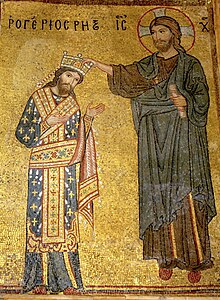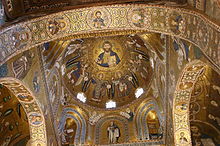Roger II (Sicily)


Roger II (born December 22, 1095 in Mileto , † February 26, 1154 in Palermo ) from the Norman noble family of the Hauteville was count from 1105 and from 1130 king of Sicily until his death .
He was the second son of Rogers I from his third marriage and after the death of his brother Simon in 1105 he became Count of Sicily , which his father Roger had conquered together with his brother Robert Guiskard . His mother Adelheid ruled for him until 1113 at the latest, as he was only nine years old at the beginning. He is seen as one of the most important rulers of the Middle Ages and was considered the richest ruler in Europe in his time.
Roger II was the grandfather of Emperor Friedrich II.
Life
Inherited by his Norman relatives in 1127 with the Duchy of Apulia (1127) and with Taranto (1128), he won all of southern Italy right down to the papal possessions . He had disagreements with popes several times. He was only on August 22, 1128 by Pope Honorius II. On a bridge in Benevento in a peace agreement with the Duchy of Apulia invested . Roger took advantage of the schism under Innocent II for his own purposes, allied himself with the antipope Anaclet II and had himself elevated to King of Sicily in Palermo at Christmas 1130 . The military conflicts with Innocent II led to the capture of the Pope in 1139 ; Innocent had to recognize Roger's royal dignity.
Roger II was considered very educated and cosmopolitan and presumably spoke not only Greek but also Arabic. He established an efficient rule over his possessions and promoted sulfur mining, silk production and the development of a merchant navy in order to conduct a profitable trade not only with Byzantium but also with the Arab and North African cities. The Arab cartographer Al-Idrisi , who created a silver map of the world for him, lived at his court .
With his legislative work, the Assises of Ariano , Roger II laid down the foundations of his royal rule in a kind of constitution based on the model of the Corpus iuris civilis of Emperor Justinian I of Byzantium . The resolutions contained therein include: a. also references to equal treatment of subjects of different faiths.
Strongly involved in the crusade movement, Roger II was soon able to acquire possessions in North Africa, which additionally favored trade and tax revenue. With the conquest of Tunis in 1146, he became the ruler of the central Mediterranean. Roger II was also considered the richest ruler in Europe in his time and maintained an extensive harem - without a role model for the West . Under him, Sicily experienced a heyday that has never been seen again today.
The Cappella Palatina , the palace chapel of King Rogers II in Palermo , shows the effects of the cultural policy of the Normans : Kufic inscriptions are found alongside biblical stories of salvation, Arabic ornamentation and Byzantine mosaic art form a synthesis.
progeny
Roger II was married three times. From his first marriage to Elvira († 1135), a daughter of Alfonso VI. of Castile , had four sons. The three eldest, Roger , Tankred and Alfons, died before their father. In 1151 he made the youngest son Wilhelm (born 1122) co-regent. As Wilhelm I, he also succeeded his father as King of Sicily.
The second marriage in 1149 with Sibylle , a daughter of Duke Hugo II of Burgundy , remained childless. Sibylle died of a miscarriage as early as 1150, the year after the wedding.
From his third marriage in 1151 with Beatrix († 1185), a daughter of Count Günther von Rethel , the only child was Konstanze , who was born after the death of Rogers II. She married the future Emperor Heinrich VI in 1186 . with which the Kingdom of Sicily passed to the Hohenstaufen .
Roger II was buried in the cathedral of Palermo , although he had intended the cathedral of Cefalù built by him as his burial place. Two sarcophagi were commissioned for this in 1145 and placed in the transept of the cathedral. While one was intended as his burial place, the other was to remain empty “as a symbol and in memory of my name ”. His grandson Friedrich II had the sarcophagi brought to Palermo for himself and his father in 1215.
reception
Roger II is the title character of Karol Szymanowski's opera Król Roger (world premiere in Warsaw 1926).
literature
- Theo Broekmann: "Rigor iustitiae". Rule, law and terror in the Norman-Staufer south (1050–1250) (= symbolic communication in the pre-modern era. Studies on history, literature and art. ). Wissenschaftliche Buchgesellschaft, Darmstadt 2005, ISBN 3-534-18060-7 (Also: Münster, University, dissertation, 2003/2004; review ).
- Carlrichard Brühl : Documents and chancellery of King Rogers II of Sicily (= studies on the Norman-Hohenstaufen rulers' deeds of Sicily. 1). Böhlau, Cologne et al. 1978, ISBN 3-412-00978-4 .
- Erich Caspar : Roger II. (1101–1154) and the establishment of the Norman-Sicilian monarchy. Wagner, Innsbruck 1904 ( digitized ; in Italian: Ruggero II. (1101–1154) e la fondazione della monarchia normanna di Sicilia (= Centro europeo di studi normanni, Ariano Irpino. Collana di fonti e studi. 7). Con un saggio introduttivo di Ortensio Zecchino. Laterza, Rome et al. 1999, ISBN 88-420-5823-8 ).
- Ferdinand Chalandon : Histoire de la domination normande en Italie et en Sicile. 2 volumes. Picard et Fils, Paris 1907, ( digitized volume 1 , digitized volume 2 ).
- Josef Deér : Papacy and Normans. Investigations into their feudal and church-political relationships (= studies and sources on the world of Emperor Frederick II. 1). Böhlau et al., Cologne et al. 1972, ISBN 3-412-95872-7 .
- Hubert Houben : Roger II of Sicily. Ruler between Orient and Occident . 2nd, bibliographically completely updated and supplemented edition. Scientific Book Society, Darmstadt 2010, ISBN 978-3-534-23113-3 .
Web links
- Publications about Roger II in the Opac der Regesta Imperii
Individual evidence
- ↑ Thomas Dittelbach: Geschichte Siziliens , Munich 2010 (= Beck'sche Reihe; 2490), ISBN 978-3-406-58790-0 , p. 39
- ^ Eva Sybille and Gerhard Rösch: Kaiser Friedrich II. And his Kingdom of Sicily, Sigmaringen: Thorbecke 1995, ISBN 3-7995-4246-9 , p. 167.
| predecessor | Office | successor |
|---|---|---|
| Simon |
Count / King of Sicily 1105–1154 |
Wilhelm I. |
| personal data | |
|---|---|
| SURNAME | Roger ii |
| BRIEF DESCRIPTION | Count of Sicily (1105–1130), King of Sicily (1130–1154) |
| DATE OF BIRTH | December 22, 1095 |
| PLACE OF BIRTH | Mileto |
| DATE OF DEATH | February 26, 1154 |
| Place of death | Palermo |

